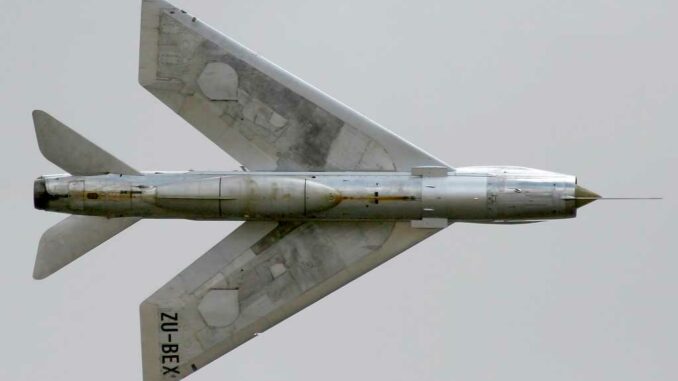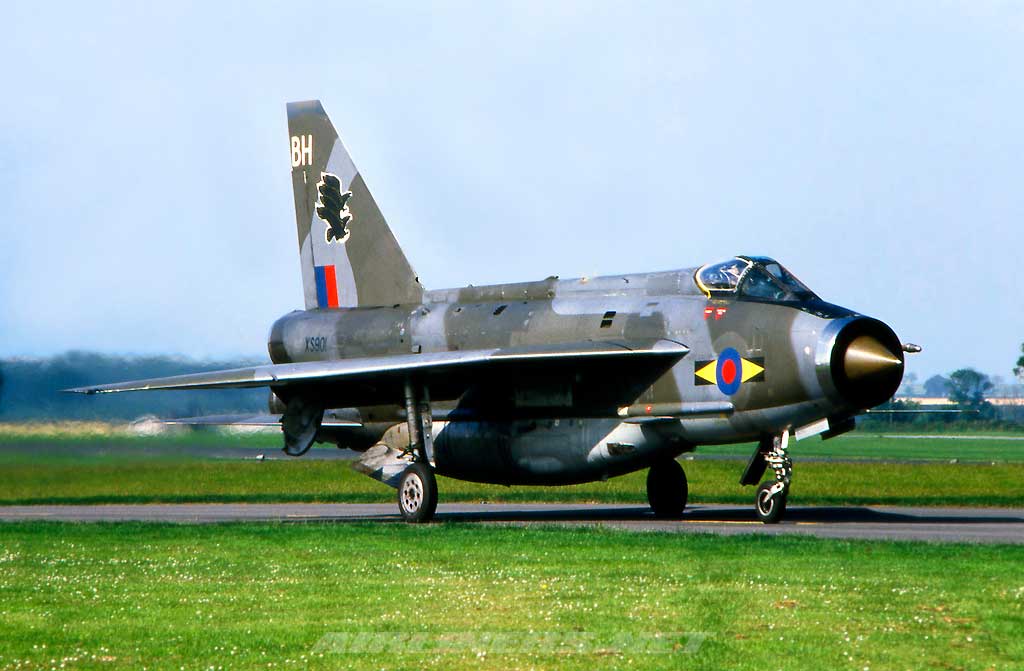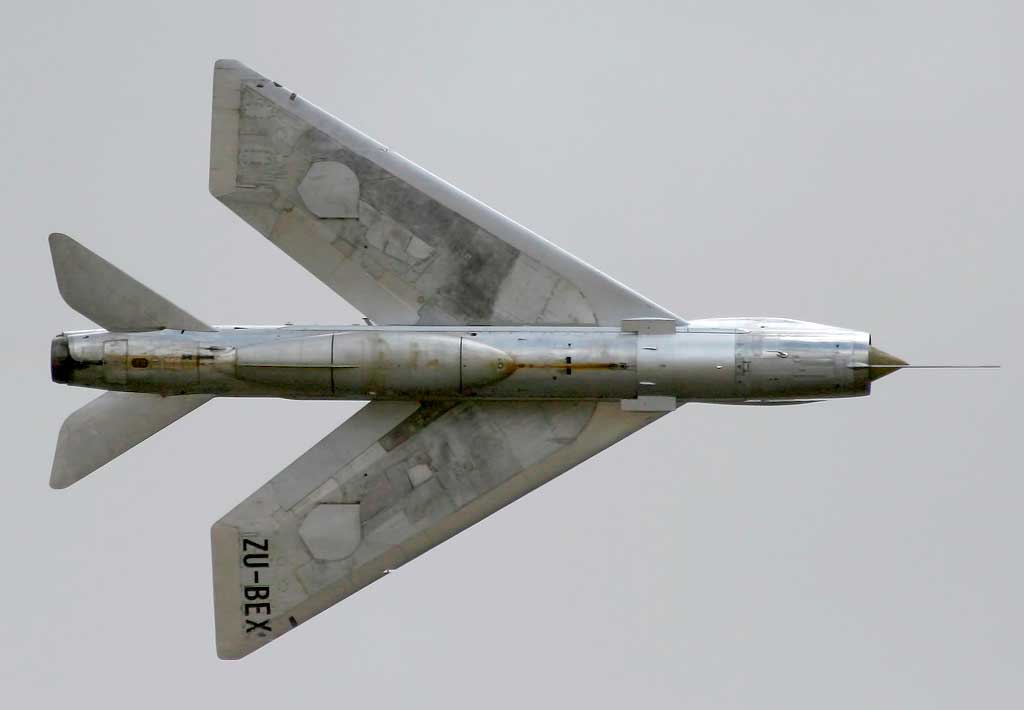
Two Rolls-Royce Avon engines, a formidable thrust-to-weight ratio, and 50,000 ft/min: how the English Electric Lightning defined rapid interception.
In summary
Designed for British air defense, the English Electric Lightning interceptor relied on raw power. With two Rolls-Royce Avon afterburners, it had a thrust-to-weight ratio that allowed it to climb instantly to 50,000 ft/min (≈ 254 m/s) and sustain around 20,000 ft/min (≈ 102 m/s). Its original architecture—two superimposed turbojets and an axial air intake with an AI.23 radar cone—is designed for rapid takeoff, supersonic acceleration (Mach 2 at altitude), and lightning-fast altitude gain to intercept intruders guided by ground control. Its limitations are well known: restricted range, virtually no air-to-ground capability, and avionics that are crude compared to later generations. But it excels in its QRA interception mission. Its “extra thrust” inspired the next generation of interceptors and foreshadowed the philosophy of high-specific-power fighters. Replaced by the Phantom and then the Tornado F.3, it left a lasting technical mark.
The design of an interceptor built for climbing
The Lightning was designed with one imperative in mind: to reach the firing zone quickly. The compact airframe houses two Rolls-Royce Avon engines installed in a “stack” in the fuselage, with a front axial intake topped by a cone housing the AI.23 radar. This arrangement reduces frontal drag and concentrates mass near the centerline, which benefits high-angle transitions and high-speed stability. The highly swept wing (approximately 60° at the leading edge), with a surface area of around 32 m², remains thin to limit drag in supersonic flight.
The narrow main landing gear, large tailplane, and voluminous ventral fuel tank are indicative of an aircraft designed for military runways, not rough terrain. Later versions adopted upper wing tanks for transport, a pragmatic solution to a chronic constraint: the aircraft carries little fuel relative to its afterburner consumption. The cockpit ergonomics and avionics suite reflect the priority: direct control, simple displays, and a short-range interception radar for the Firestreak and then Red Top missiles.

Performance that changes the kinematics of interception
The Lightning’s “signature” comes from its power. Two Avon 300 series engines each provide more than 70 kN in afterburner, or around 140–150 kN available depending on the version. At interception weight, the thrust-to-weight ratio can approach unity, allowing for strong acceleration during climb. The figures speak for themselves: 50,000 ft/min (≈ 254 m/s) during the first altitude segment, around 20,000 ft/min (≈ 102 m/s) sustained, and a top speed close to Mach 2 at high altitude (≈ 2,100–2,200 km/h depending on conditions).
The afterburner engine reaction allows for rapid energy recovery after a sharp turn. The aircraft then gains verticality: certain light profiles allow for a quasi-axial climb with rapid transonic transition. This “rocket-like” behavior is not a gimmick: in a ground station-guided interception, every second gained in climb or acceleration adds degrees of angle of attack or hundreds of meters of altitude at the moment of firing. Combined with the low lateral inertia of a narrow airframe, this power makes the Lightning very credible in a “drag race” against an aircraft penetrating at high altitude.
Mission utility: QRA interception without detours
In a QRA interception posture, the sequence is simple: alert, takeoff, climb, acquisition, firing, or escort. The Lightning’s strength lies in its ability to reduce vertical transit time. Typically, the aircraft reaches 10,000 m in a few tens of seconds and then continues to 15–18 km depending on the threat and rules of engagement. The AI.23 radar provides initial acquisition assistance and tracking for missile presentation. The Red Top/AI.23 combination improves the chances of firing at close range compared to the Firestreak, while remaining within a short-range IR logic.
The structural weakness remains the range: afterburning consumes kerosene. Crews therefore adopt energy management profiles: heated climb, limited acceleration plateau, return to dry running, or even refueling if necessary. Despite this constraint, the ability to quickly “cap” a target flying high and fast is exactly what a control center expects: the aircraft reduces the intrusion time before interception and limits the geographical space where an uncooperative intruder can operate without escort.
Technology at the service of firing: radar, missiles, and energy
The AI.23 radar is not a modern BVR system, but it provides useful angle and distance measurements for short-range attacks and filtering clutter at medium altitude. In its intended area of use—high, cold, fast—its role is to bring the encounter geometry into the IR missile window and assist with identification. The Red Top, which is more tolerant in terms of angle of attack and more sensitive than the Firestreak, makes the most of the rapid presentations enabled by the Lightning’s acceleration.
The physical key remains specific energy: the aircraft converts its thrust into altitude and speed with little loss. This energy margin translates into tactical choices: engage from high altitude to retain the option of diving back down, or accept a less favorable angle of engagement because the re-acceleration time is short. In a point defense context, this dynamic partially compensates for the lack of weapons beyond visual range on the early versions.
Influence on the next generation and performance equivalents
The Lightning influences doctrine more than the shape of aircraft. Its message is clear: an interceptor must have extra thrust to impose its will vertically. This logic is found, on a larger scale and with superior sensors, in the F-15: higher mass but a thrust-to-weight ratio greater than 1 in combat configuration, with comparable climbs at the beginning of the profile. Other contemporary aircraft rely on specific power: F-104 Starfighter (powerful J79, high initial climb), Mirage III (Atar 9, sleek and fast), MiG-21 (R-25-300 on the latest versions, very responsive in short climbs).
In contrast, the MiG-25 displays spectacular peaks in speed and altitude, but its instantaneous climb is explained more by raw thrust and intake geometry than by comparable agility. The Lightning remains unique in its ability to “break away” as soon as it leaves the airfield with a compact airframe. This philosophy permeates subsequent programs: before complex sensors, having sufficient energy capital simplifies interception.

Replacement and end of service
The evolution of threats and sensors made succession inevitable. The Lightning gradually gave way to the British Phantom, which was better equipped with radar and semi-active weaponry, and then to the Tornado F.3, which offered endurance, modernized tracking avionics, and medium-range missiles. The “purely energy-based” interceptor is losing its relevance as long-range detection, identification, and BVR firing become the norm.
However, operational evidence remains consistent: in its field, the Lightning is still going strong. Air defense units appreciate its climb, high-speed performance, and ability to quickly break through layers. Its limitations—range, reduced offensive payload, basic avionics—are the flip side of a conscious choice: prioritizing aeronautical power to win the time duel.
What the Lightning still teaches us today
The aircraft highlights three constants of QRA interception. First, the “time window” is as important as distance: gaining 30 seconds in climb changes the geometry of a shot. Second, well-managed specific energy is as good as a sensor: an aircraft that accelerates and climbs without delay imposes its own rhythm. Finally, the simplicity of the decision chain reduces errors: readable radar, clear trajectories, missiles consistent with kinematics.
In today’s forces, multi-role fighters have taken over with fused sensors and long-range missiles. However, the intuition inherited from the Lightning remains: a generous thrust-to-weight ratio opens up tactical margins, especially when countering a fast and high profile. Technology has changed, but physics has not.
War Wings Daily is an independant magazine.